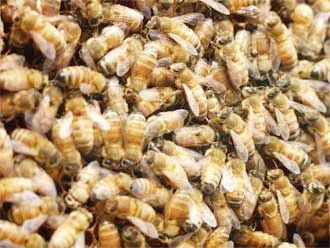
We thought it might bee an interesting blog post to put together all the coolest bee facts, along with Stephen's beeautiful pictures, and beefore you know it, you'll want 'em too just so you can sit around and watch them work.
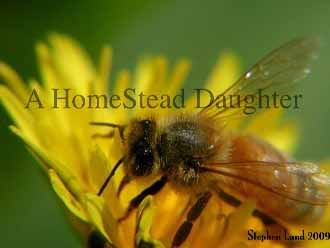
Stephen went along (at a safe distance) to take pictures when Andrew checked the hives a few days ago. Now you can take a close up peek without even having to suit up!
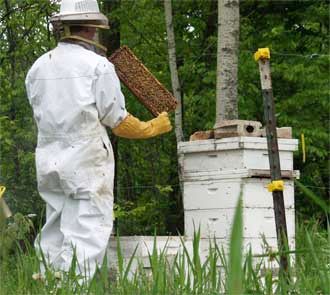
This year we decided to take a more natural, 'leave em bee', kind of approach. Part of that was letting them build their own comb. Your ordinary bee keepers don't usually opt for this because sometimes the bees will get "creative" (as in, not putting the comb where you want it), and generally cells of the comb are slightly smaller, resulting in smaller, natural-sized bees. However, it's more healthy for them beecause it's what their little bodies are used to doing in the wild.
Here's a frame where comb is just being started. So far the bees have been cooperating with our comb-placement suggestions very nicely!

This one is just about full.

And here's one where they've already beegun capping off their honey with wax.
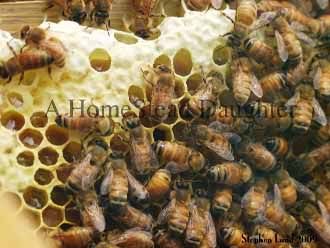
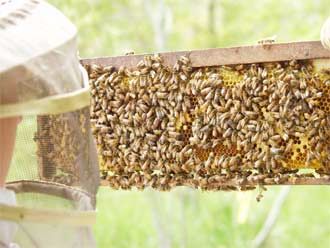
Contrary to popular beelief,
 bees will usually not sting you when they're out getting their nectar and pollen. In fact, the kids love to stun people by carrying around and/or petting their furry friends.
bees will usually not sting you when they're out getting their nectar and pollen. In fact, the kids love to stun people by carrying around and/or petting their furry friends. 
They don't sting very often beecause their stingers are attached to their guts and when they sting, their guts get pulled out and they die, so they only do it in self sacrificing defense of their hive.
The bees that you see out pollenating flowers are the female workers.
 The guys (aka: drones) are sitting back at the hive getting fat! (Oh, the irony...) Their only job is to mate the queen. To do this they fly up to three hundred feet in the air above their hives. Then, when they're done, the drone falls back to earth--dead! They have no stinger and don't do any work, hence the reason the worker ladies will literally kick them out of the hive come winter.
The guys (aka: drones) are sitting back at the hive getting fat! (Oh, the irony...) Their only job is to mate the queen. To do this they fly up to three hundred feet in the air above their hives. Then, when they're done, the drone falls back to earth--dead! They have no stinger and don't do any work, hence the reason the worker ladies will literally kick them out of the hive come winter.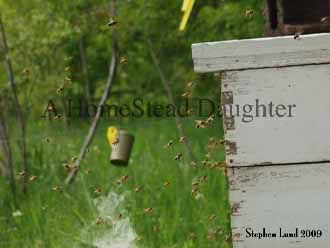
Other interesting facts: It takes about 556 workers to gather 1 pound of honey from about 2 million flowers. A honey bee visits 50 to 100 flowers during a collection trip.

The honeybee's wings stroke 11,400 times per minute, thus making their distinctive buzz.

A honey bee can fly for up to six miles, and as fast as 15 miles per hour, hence it would have to fly around 90,000 miles - three times around the globe - to make one pound of honey.
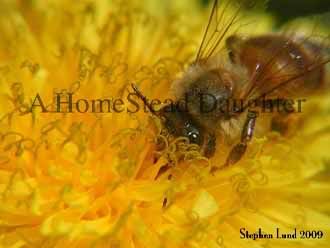
The average honey bee will actually make only one twelfth of a teaspoon of honey in its lifetime.
Bees have six legs. Only the worker bees have pollen sacks on their back legs. Bees collect the pollen by wetting it with their saliva and, using their middle legs, they stuff it into the sacks on their hind legs.
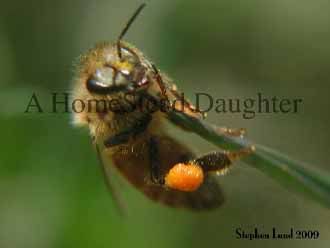
While the worker bees only live from 6 weeks to 3 months (during the summer they literally work themselves to death), the queen can live 3 to 5 years. In the event that a queen should die unexpectedly, the whole hive stops production and waits while a new queen is hatched. A queen is made by simply feeding an ordinary bee larva the royal jelly. It's a powerful, milky substance made of digested pollen and honey or nectar mixed with a chemical secreted from a gland in a nursing bee's head. Queens will lay up to 2000 eggs a day at a rate of 5 or 6 a minute.
Bee's are so productive, they're working constantly at what seems like an impossible chore! Makes me feel terribly lazy to just lay in the yard and watch them work. I think there's a lesson to bee learned from these beezy bugs.
Hope you're having a beeutiful day!
Mary

amazing facts! makes me appreciate a teaspoon of honey! Aunt Mary
ReplyDeleteI wanted to share the joy we experienced meeting you all this past weekend. Fr. Michael is so blessed to have such good friends! We feel the same way...your blog is awesome! I'll check it often. keep up the great work! The cabin is very cool! Please take good care, we'll keep you always in our prayers.
ReplyDeletewow i found this post to be very interesting thank you : ). Stephen
ReplyDeleteThat looks like the most interesting science text I have ever seen.
ReplyDeleteI sent the link to Dan Miller so he could see what you are doing with the bee equipment.
You never cease to amaze us. What is next?
May God continue to reward you !
Mrs. M.